

The trema is also sometimes called a “diaeresis” or “umlaut”, although technically it’s not an umlaut. It can be found above an “e”, “i”, or “u”: ë, ï, ü. The Trema (L’Accent Tréma) in French Finally, we have the trema: two little dots above a letter. What are the two dots above a letter called in French?

Your tongue must stay in the same place as when you say the sound “ee” and you should only change the shape of your mouth as if we’re saying “oo”. The way to pronounce the Ü umlaut is by making the sound “ee” and pursing your lips as if you were whistling, almost completely shut. Release the keys, and then type a vowel in upper or lower case. Hold down the “Ctrl” and “Shift” keys, and then press the colon key. the open e), no matter what comes around it, and is used in groups of vowels that would otherwise be pronounced differently. The diaeresis (the two dots) signifies that the underlying “e” is pronounced as /ɛ/ (as “e” in “bet”, i.e. Ë with diaeresis is the easiest case to deal with. 2 : the break in a verse caused by the coincidence of the end of a foot with the end of a word.

Often mistakenly called an umlaut, a diaeresis (pronounced “die heiresses” it’s from the Greek for “divide,” and is devilishly hard to spell) consists of two dots carefully centered over the second vowel in such words as “naïve” and “reëlection.” An umlaut is a German thing that alters the pronunciation of a vowel ( …ġ : a mark ¨ placed over a vowel to indicate that the vowel is pronounced in a separate syllable (as in naïve or Brontë) - compare umlaut.


 0 kommentar(er)
0 kommentar(er)
